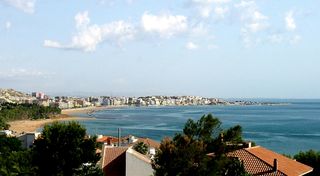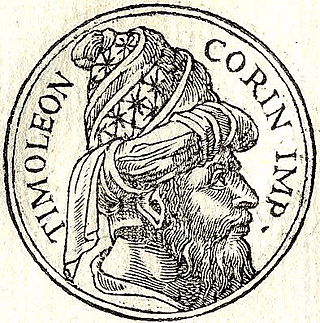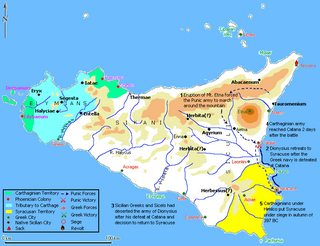Related Research Articles

Syracuse is a historic city on the Italian island of Sicily, the capital of the Italian province of Syracuse. The city is notable for its rich Greek and Roman history, culture, amphitheatres, architecture, and as the birthplace and home of the pre-eminent mathematician and engineer Archimedes. This 2,700-year-old city played a key role in ancient times, when it was one of the major powers of the Mediterranean world. Syracuse is located in the southeast corner of the island of Sicily, next to the Gulf of Syracuse beside the Ionian Sea. It is situated in a drastic rise of land with 2,000 metres (6,600 ft) depths being close to the city offshore although the city itself is generally not so hilly in comparison.

Magna Graecia was the name given by the Romans to the Greek-speaking coastal areas of Southern Italy in the present-day Italian regions of Calabria, Apulia, Basilicata, Campania and Sicily; these regions were extensively populated by Greek settlers starting from the 8th century BC.
This article concerns the period 349 BC – 340 BC.

Crotone is a city and comune in Calabria, Italy.

Timoleon, son of Timodemus, of Corinth was a Greek statesman and general.

Dionysius I or Dionysius the Elder was a Greek tyrant of Syracuse, Sicily. He conquered several cities in Sicily and southern Italy, opposed Carthage's influence in Sicily and made Syracuse the most powerful of the Western Greek colonies. He was regarded by the ancients as an example of the worst kind of despot: cruel, suspicious, and vindictive.

The Italiotes were the pre-Roman Greek-speaking inhabitants of the Italian Peninsula, between Naples and Calabria.
The siege of Rhegium was undertaken in 387 BC by a Syracusan force against the city of Rhegium. The Syracusans were led by the tyrant Dionysius I. Dionysius took the city, and sold its inhabitants into slavery.

The siege of Syracuse in 397 BC was the first of four unsuccessful sieges Carthaginian forces would undertake against Syracuse from 397 to 278 BC. In retaliation for the siege of Motya by Dionysius of Syracuse, Himilco of the Magonid family of Carthage led a substantial force to Sicily. After retaking Motya and founding Lilybaeum, Himilco sacked Messana, then laid siege to Syracuse in the autumn of 397 BC after the Greek navy was crushed at Catana.

Kamarina or Camarina was an ancient city on the southern coast of Sicily in Magna Graecia. The ruins of the site and an archaeological museum are located south of the modern town of Scoglitti, a frazione (borough) of the comune (municipality) of Vittoria in the province of Ragusa.

The Italiote League of city-states was founded in about 430 BC by several Greek Achaean colonies in southern Italy.

The Sicilian Wars, or Greco-Punic Wars, were a series of conflicts fought between ancient Carthage and the Greek city-states led by Syracuse over control of Sicily and the western Mediterranean between 580 and 265 BC.
Leptines was a military leader from Syracuse, Sicily, Magna Graecia, active during his brother, Dionysius the Elder's wars. He showed bravery in the fights against Carthage and mercy with the Thurians.

The Battle of Gela took place in the summer of 405 BC in Sicily. The Carthaginian army under Himilco, which had spent the winter and spring in the captured city of Akragas, marched to confront the Greeks at Gela. The Syracuse government had deposed Daphnaeus, the unsuccessful general of the Greek army at Akragas, with Dionysius, another officer who had been a follower of Hermocrates. Dionysius schemed and gained full dictatorial powers.
The Battle of Abacaenum took place between the Carthaginian forces under Mago and the Siceliot army under Dionysius in 393 BC near the Sicilian town on Abacaenum in north-eastern Sicily. Dionysius, tyrant of Syracuse, had been expanding his influence over Sicels' territories in Sicily. After Dionysius' unsuccessful siege in 394 BC of Tauromenium, a Carthaginian ally, Mago decided to attack Messana. However, the Carthaginian army was defeated by the Greeks near the town of Abacaenum and had to retire to the Carthaginian territories in Western Sicily. Dionysius did not attack the Carthaginians but continued to expand his influence in eastern Sicily.
The Battle of Chrysas was fought in 392 BC in the course of the Sicilian Wars, between the Carthaginian army under Mago and a Greek army under Dionysius I, tyrant of Syracuse, who was aided by Agyris, tyrant of the Sicel city of Agyrium. Mago had been defeated by Dionysius at Abacaenum in 393, which had not damaged the Carthaginian position in Sicily. Reinforced by Carthage in 392, Mago moved to attack the Sicles allied with Syracuse in central Sicily. After the Carthaginians reached and encamped near the river Chrysas, the Sicels harassed the Carthaginian supply lines causing a supply shortage, while the Greek soldiers rebelled and deserted Dionysius when he refused to fight a pitched battle. Both Mago and Dionysius agreed to a peace treaty, which allowed the Carthaginians to formally occupy the area west of the River Halycus, while Dionysius was given lordship over the Sicel lands. The peace would last until 383, when Dionysius attacked the Carthaginians again.
The siege of Tauromenium was laid down by Dionysius, tyrant of Syracuse, in the winter of 394 BC, in the course of the Sicilian Wars against Carthage. After defeating the Carthaginians at the Battle of Syracuse in 397 BC, Dionysius had been expanding his territory and political influence by conquering Sicel lands and planting Greek colonies in northeastern Sicily. Tauromenium was a Sicel city allied to Carthage and in a position to threaten both Syracuse and Messina. Dionysius laid siege to the city in the winter of 394 BC, but had to lift the siege after his night assault was defeated. Carthage responded to this attack on their allies by renewing the war, which was ended by a peace treaty in 392 BC that granted Dionysius overlordship of the Sicels, while Carthage retained all territory west of the Halykos and Himera rivers in Sicily.
The siege of Segesta took place either in the summer of 398 BC or the spring of 397 BC. Dionysius the Elder, tyrant of Syracuse, after securing peace with Carthage in 405 BC, had steadily increased his military power and tightened his grip on Syracuse. He had fortified Syracuse against sieges and had created a large army of mercenaries and a large fleet, in addition to employing catapults and quinqueremes for the first time in history. In 398 BC he attacked and sacked the Phoenician city of Motya despite a Carthaginian relief effort led by Himilco II of Carthage. While Motya was under siege, Dionysius besieged and assaulted Segesta unsuccessfully. Following the sack of Motya, Segesta again came under siege by Greek forces, but the Elymian forces based in Segesta managed to inflict damage on the Greek camp in a daring night assault. When Himilco of Carthage arrived in Sicily with the Carthaginian army in the spring of 397 BC, Dionysius withdrew to Syracuse. The failure of Dionysius to secure a base in western Sicily meant the main events of the Second Sicilian war would be acted out mostly in eastern Sicily, sparing the Elymian and Phoenician cities the ravages of war until 368 BC.

Greek coinage of Italy and Sicily originated from local Italiotes and Siceliotes who formed numerous city states. These Hellenistic communities descended from Greek migrants. Southern Italy was so thoroughly hellenized that it was known as the Magna Graecia. Each of the polities struck their own coinage.
Hélōris, was a Syracusan exile from Magna Graecia, who fought against his adoptive son, the tyrant Dionysius I of Syracuse.
References
- Tucker, Spencer C. (2010). A Global Chronology of Conflict: from the Ancient World to the Modern Middle East; Volume I: ca. 3000 BCE - 1499 CE. Santa Barbara, Denver, Oxford: ABC-CLIO. ISBN 978-1-85109-667-1.